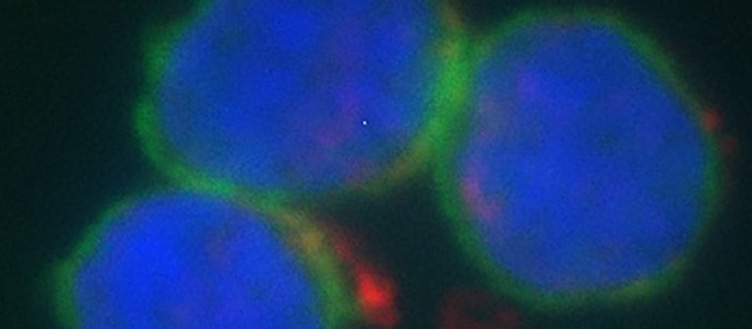Jul 1 2019
The use of nanoparticles in medicine has progressively increased in the last two decades. However, their safety and impact on the human immune system is still a significant concern.
By testing various types of gold nanoparticles, scientists at the University of Geneva (UNIGE), in partnership with the National Centre of Competence in Research “Bio-inspired Materials” and Swansea University Medical School, (UK), are demonstrating the first proof of their impact upon human B lymphocytes – the immune cells accountable for antibody production.
 B lymphocytes (blue and green) and gold nanoparticles (red) measured with dark field hyperspectral imaging coupled with fluorescent detection. (© UNIGE)
B lymphocytes (blue and green) and gold nanoparticles (red) measured with dark field hyperspectral imaging coupled with fluorescent detection. (© UNIGE)
The use of these nanoparticles is anticipated to enhance the effectiveness of pharmaceutical products while controlling possible adverse effects. These results, reported in the journal ACS Nano, will pave the way towards the development of more targeted and better tolerated therapies, especially in the field of oncology. The methodology formulated renders it also possible to analyze the biocompatibility of any nanoparticle at the initial developmental stage of a new nanodrug.
Accountable for the making of antibodies, B lymphocytes are a vital part of the human immune system, and thus an appealing target for the progress of preventive and therapeutic vaccines. But, to realize their goal, vaccines have to reach B lymphocytes rapidly without being destroyed, making the use of nanoparticles interesting on the whole.
“Nanoparticles can form a protective vehicle for vaccines – or other drugs – to specifically deliver them where they can be most effective, while sparing other cells,” explains Carole Bourquin, a Professor at the UNIGE’s Faculties of Medicine and Science, who co-led this research. “This targeting also allows the use of a lower dose of immunostimulant while maintaining an effective immune response. It increases its efficacy while reducing side-effects, provided that the nanoparticles are harmless to all immune cells.”
Analogous studies have already been carried out for other immune cells like macrophages, which look for and interact with nanoparticles, but never before for the smaller and harder to handle, B lymphocytes.
Gold is an ideal material
Gold is a great option for nanomedicine due to its specific physico-chemical properties. Well accepted by the body and easily malleable, this metal possesses, for example, the particularity of absorbing light and then discharging heat, a property that can be leveraged in oncology.
“Gold nanoparticles can be used to target tumours. When exposed to a light source, the nanoparticles release heat and destroy neighbouring cancer cells. We could also attach a drug to the surface of the nanoparticles to be delivered to a specific location,” explains UNIGE researcher Sandra Hočevar.
She further adds,“To test their safety and the best formula for medical use, we have created gold spheres with or without a polymer coating, as well as gold rods to explore the effects of coating and shape. We then exposed human B lymphocytes to our particles for 24 hours to examine the activation of the immune response.”
By using activation markers expressed on the surface of B cells as a guide, the researchers could establish how much their nanoparticles triggered or repressed the immune response. While none of the nanoparticles tested showed contrary effects, their impact on the immune response varied according to their shape and the presence of a surface, polymer coating.
Surface properties, as well as nanoparticle morphology definitely are important when it comes to the nanoparticle-cell interaction. Interestingly, the gold nanorods inhibited the immune response instead of activating it, probably by causing interference on the cell membrane, or because they are heavier.
Martin Clift, Project Co-Lead and Associate Professor of Nanotoxicology and In Vitro Systems, Swansea University Medical School
Uncoated, spherical particles effortlessly aggregate and are thus not suitable for biomedical application. In contrast, gold spheres coated with a protective polymer are constant and do not weaken the B lymphocyte function.
And we can easily place the vaccine or drug to be delivered to the B lymphocytes in this coating. In addition, our study established a methodology for assessing the safety of nanoparticles on B lymphocytes, something that had never been done before. This could be especially useful for future research, as the use of nanoparticles in medicine still requires clear guidelines.
Carole Bourquin, Study Co-Lead and Professor, Faculties of Medicine and Science, UNIGE
Many clinical applications
B cells are at the core of vaccine response, but also in other areas such as autoimmune diseases and oncology. The gold nanoparticles created by the scientists could make it possible to convey existing drugs straight to B lymphocytes, thus decreasing the required dosage and possible side effects. Actually, studies in patients are already being conducted for brain tumor treatment. Gold nanoparticles can be produced sufficiently small to penetrate the blood-brain barrier, allowing specific anti-tumoral drugs to be conveyed straight into the cancerous cells.